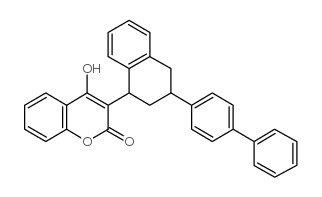Whole-carcass residues of the rodenticide difenacoum in anticoagulant-resistant and -susceptible rat strains (Rattus norvegicus).
Helen Atterby, Gerard M Kerins, Alan D MacNicoll
Index: Environ. Toxicol. Chem. 24(2) , 318-23, (2005)
Full Text: HTML
Abstract
The present study investigated the whole-carcass residue carried by resistant and susceptible laboratory rat strains following 5, 10, or 20 d of feeding on a diet of 25 mg difenacoum/kg bait. The mean whole-carcass residue of difenacoum was determined by high-performance liquid chromatography to be between 0.52 and 0.74 mg/kg body weight in all three rat strains tested. These values were considerably lower than some comparable data previously reported for other species and second-generation rodenticides as well as from mathematical models. The whole-carcass residue of extractable (i.e., nonrefractory) parent compound carried by highly resistant rats fed for 20 d (0.74 mg/kg body wt) is unlikely to present a significantly increased risk to predators compared to the amount carried by susceptible rats after 5 d of feeding (0.52 mg/kg body wt). However, resistant rats are more likely to be available for predation and to be carrying a whole-carcass residue of anticoagulant throughout the duration of a control program.
Related Compounds
| Structure | Name/CAS No. | Molecular Formula | Articles |
|---|---|---|---|
 |
Difenacoum
CAS:56073-07-5 |
C31H24O3 |
|
Fast targeted analysis of 132 acidic and neutral drugs and p...
2014-10-01 [Forensic Sci. Int. 243 , 35-43, (2014)] |
|
Use of two halogenated biphenyls as indicators of non-target...
1995-04-01 [Bull. Environ. Contam. Toxicol. 54(4) , 526-33, (1995)] |
|
Spatial and temporal analysis of second-generation anticoagu...
2003-01-01 [Environ. Pollut. 122(2) , 183-93, (2003)] |
|
High exposure rates of anticoagulant rodenticides in predato...
2012-10-01 [Arch. Environ. Contam. Toxicol. 63(3) , 437-44, (2012)] |
|
Concentrations of anticoagulant rodenticides in stoats Muste...
2011-05-15 [Sci. Total Environ. 409(12) , 2373-8, (2011)] |